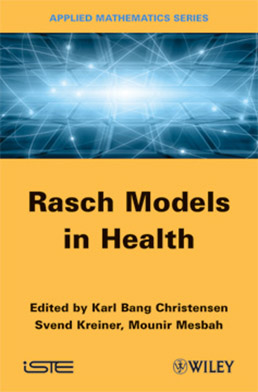
The family of statistical models known as Rasch models started with a simple model for responses to questions in educational tests presented together with a number of related models that the Danish mathematician Georg Rasch referred to as models for measurement. Since the beginning of the 1950s the use of Rasch models has grown and has spread from education to the measurement of health status. This book contains a comprehensive overview of the statistical theory of Rasch models. Part 1 contains the probabilistic definition of Rasch models, Part 2 describes the estimation of item and person parameters, Part 3 concerns the assessment of the data-model fit of Rasch models, Part 4 contains applications of Rasch models, Part 5 discusses how to develop health-related instruments for Rasch models, and Part 6 describes how to perform Rasch analysis and document results.
Part 1. Probabilistic Models
1. The Rasch Model for Dichotomous Items, Svend Kreiner.
2. Rasch Models for Ordered Polytomous Items, Mounir Mesbah and Svend Kreiner.
Part 2. Inference in the Rasch Model
3. Estimation of Item Parameters, Karl Bang Christensen.
4. Person Parameter Estimation and Measurement in Rasch Models, Svend Kreiner and Karl Bang Christensen.
Part 3. Checking the Rasch Model
5. Item Fit Statistics, Karl Bang Christensen and Svend Kreiner.
6. Overall Tests of the Rasch Model, Svend Kreiner and Karl Bang Christensen.
7. Local Dependence, Ida Marais.
8. Two Tests of Local Independence, Svend Kreiner and Karl Bang Christensen.
9. Dimensionality, Mike Horton, Ida Marais and Karl Bang Christensen.
Part 4. Applying the Rasch Model
10. The Polytomous Rasch Model and the Equating of Two Instruments, David Andrich.
11. A Multidimensional Latent Class Rasch Model for the Assessment of the Health-Related Quality of Life, Silvia Bacci and Francesco Bartolucci.
12. Analysis of Rater Agreement by Rasch and IRT Models, Jørgen Holm Petersen
13. From Measurement to Analysis, Mounir Mesbah.
14. Analysis with Repeatedly Measured Binary Item Response Data by Adhoc Rasch Scales, Volkert Siersma and Paolo Eusebi.
Part 5. Creating, Translating and Improving Rasch Scales
15. Writing Health-Related Items for Rasch Models – Patient-Reported Outcome Scales for Health Sciences: From Medical Paternalism to Patient Autonomy, John Brodersen, Lynda C. Doward, Hanne Thorsen and Stephen P. McKenna.
16. Adapting Patient-Reported Outcome Measures for Use in New Languages and Cultures, Stephen P. McKenna, Jeanette Wilburn, Hanne Thorsen and John Brodersen.
17. Improving Items That Do Not Fit the Rasch Model, Tine Nielsen and Svend Kreiner.
Part 6. Analyzing and Reporting Rasch Models
18. Software for Rasch Analysis, Mounir Mesbah.
19. Reporting a Rasch Analysis, Thomas Salzberger.
Karl Bang Christensen is Associate Professor at the Department of Biostatistics at the University of Copenhagen in Denmark. With a background in mathematical statistics he has worked mainly within Biostatistics and Epidemiology. Inspired by the issue of measurement in social and health sciences he has published methodological work about Rasch models in journals such as Applied Psychological Measurement, the British Journal of Mathematical and Statistical Psychology and Psychometrika.
Svend Kreiner is Professor at the Deptartment of Biostatistics, Institute of Public Health, University of Copenhagen, Denmark. He has for some years tried to combine his interest in Rasch models with his interest in graphical models for categorical data and has developed a family of Rasch-related models that he refers to as graphical loglinear Rasch models in which several of the problems with Rasch models for social and health science data have been resolved.
Mounir Mesbah is Professor of Statistics at the Department of Mathematics and Statistics, University Pierre and Marie Curie, Paris, France. Within the Department of Mathematics and Statistics, he is currently teaching at the ISUP (UPMC Institute of Statistics) and is in charge of biostatistical options.